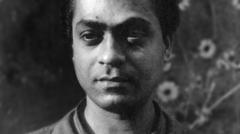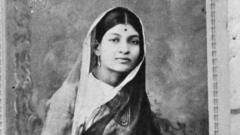Vasudeo Gaitonde, born on November 2, 1924, emerged as a legendary figure in Indian art, blending Western techniques with Asian philosophies to create profoundly meditative works that continue to capture the world's attention.
The Enigmatic Legacy of Vasudeo Gaitonde: India’s Abstract Pioneer

The Enigmatic Legacy of Vasudeo Gaitonde: India’s Abstract Pioneer
Exploring the life and artistic journey of Vasudeo Gaitonde, a master of abstract painting who revolutionized Indian art.
Vasudeo Santu Gaitonde is celebrated as one of South Asia's foremost abstract painters, having left a significant mark on the art world during his lifetime. Born a century ago on November 2, 1924, Gaitonde’s artistic journey began amid the post-colonial turmoil in India, where he became part of a transformative movement in the mid-20th century. Drawing inspiration from Western artistic movements, he skillfully incorporated elements of Asian philosophy into his work, achieving an ethereal quality that reflects light and texture in mesmerizing ways.
Known for his reclusive nature, Gaitonde sought peace and serenity in his art, using his canvas as a medium for deep introspection. "The silence of the canvas" was paramount to him, he expressed in a rare 1991 interview. His background was humble; he grew up in a modest home in Mumbai and faced family resistance when pursuing his passion for art, which was deemed an impractical career at the time. Undeterred, Gaitonde honed his skills at the prestigious JJ School of Arts, earning his diploma in 1948 against the odds.
He initially emerged as a member of the Progressive Artists Group in Mumbai, alongside luminaries like MF Husain and SH Raza, challenging the dominant realist styles of the era. Gaitonde's work represents a break from traditional forms into a realm of abstraction. He believed that his paintings mirrored nature itself, as he once reflected, "My paintings are nothing else but the reflection of nature."
His artistry received widespread acclaim; in 1963, American abstract painter Morris Graves recognized Gaitonde's potential and drew attention to his work, cementing his reputation among international art circles. Gaitonde's recognition peaked in 1971 when he was honored with the Padma Shri, India's prestigious civilian award. Despite this growing acclaim, he chose a life of solitude, often withdrawing from the public eye, making appearances rare and sought after.
The declining volume of his work post-1984, following a severe spinal injury, added to the mystique surrounding him. Gaitonde would often state that although he painted less, he continued to create in his mind, implying an everlasting connection to his art. His death in 2001 went largely unnoticed, yet his legacy refused to fade. Works by Gaitonde have consistently commanded high prices at auctions, with one painting fetching nearly $5 million in 2022, further validating his status in the art world.
Today, lovers of art regard Gaitonde's pieces as embodiments of serenity and introspection, often described as visual representations of silence infused with vibrant energy. His methodology and philosophy continue to resonate with artists and curators alike, sustaining a fascination with his rich, yet enigmatic contribution to Indian contemporary art. As Cara Manes from the Museum of Modern Art articulated, Gaitonde's works capture a “shimmering effect” that emerges from profound silence, establishing him as a timeless figure in the symphony of global art.
Known for his reclusive nature, Gaitonde sought peace and serenity in his art, using his canvas as a medium for deep introspection. "The silence of the canvas" was paramount to him, he expressed in a rare 1991 interview. His background was humble; he grew up in a modest home in Mumbai and faced family resistance when pursuing his passion for art, which was deemed an impractical career at the time. Undeterred, Gaitonde honed his skills at the prestigious JJ School of Arts, earning his diploma in 1948 against the odds.
He initially emerged as a member of the Progressive Artists Group in Mumbai, alongside luminaries like MF Husain and SH Raza, challenging the dominant realist styles of the era. Gaitonde's work represents a break from traditional forms into a realm of abstraction. He believed that his paintings mirrored nature itself, as he once reflected, "My paintings are nothing else but the reflection of nature."
His artistry received widespread acclaim; in 1963, American abstract painter Morris Graves recognized Gaitonde's potential and drew attention to his work, cementing his reputation among international art circles. Gaitonde's recognition peaked in 1971 when he was honored with the Padma Shri, India's prestigious civilian award. Despite this growing acclaim, he chose a life of solitude, often withdrawing from the public eye, making appearances rare and sought after.
The declining volume of his work post-1984, following a severe spinal injury, added to the mystique surrounding him. Gaitonde would often state that although he painted less, he continued to create in his mind, implying an everlasting connection to his art. His death in 2001 went largely unnoticed, yet his legacy refused to fade. Works by Gaitonde have consistently commanded high prices at auctions, with one painting fetching nearly $5 million in 2022, further validating his status in the art world.
Today, lovers of art regard Gaitonde's pieces as embodiments of serenity and introspection, often described as visual representations of silence infused with vibrant energy. His methodology and philosophy continue to resonate with artists and curators alike, sustaining a fascination with his rich, yet enigmatic contribution to Indian contemporary art. As Cara Manes from the Museum of Modern Art articulated, Gaitonde's works capture a “shimmering effect” that emerges from profound silence, establishing him as a timeless figure in the symphony of global art.
















